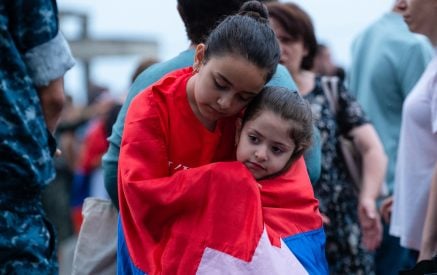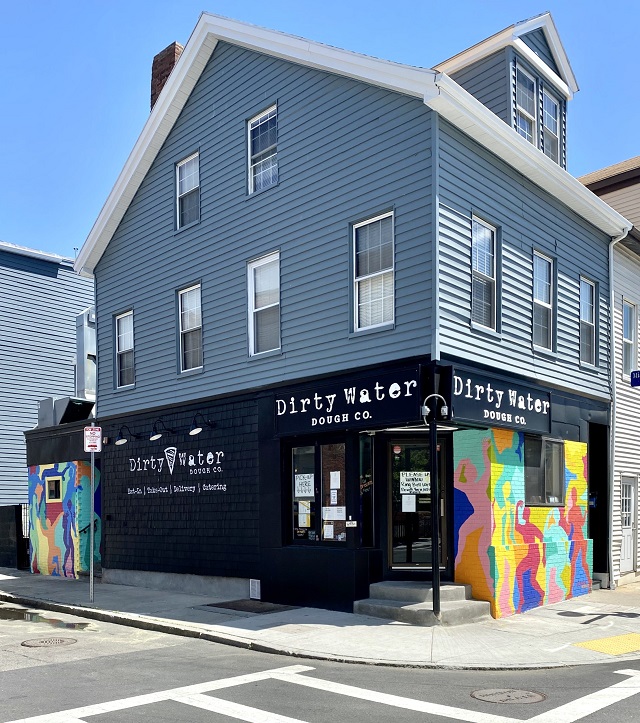The Armenian Weekly. Local artist Masha Kenyan finds beauty in chaos…even something as all-consuming and cataclysmic as war in her homeland.
“When the war started, I lost touch with reality,” she reflected one Sunday afternoon from her underground art studio on Boston’s famed Newbury Street. She’s thousands of miles from Armenia, which is now reeling from the loss of far too many young lives and swaths of sacred land after its unequal 45-day war with Azerbaijan and Turkey. “War was something that I shared with others. It wasn’t just for me,” explained Keryan. “For the first time, I felt like I was making something, and I wasn’t the only person experiencing it.”
Almost one week after the war broke out, Keryan released “No time to die”—a reactive piece that exemplified a sense of purpose for all Armenians to take action in the face of this existential threat. That week, Azerbaijan began targeting civilians in Stepanakert, forcing families to seek shelter underground or flee their homes…uncertain when or if they would ever return. A burning crimson piece titled “I just want to be left in peace” followed—an aggrieved reminder of the Armenian experience, wrought by the same oppressive forces inspired by the same masterminds of yore throughout a long, hard history. The meek subjects seem pained; one appears to be crying, as the blood red oil paint folds over his tear duct. “My pieces are very reflective of reality,” described Keryan. “Every single one is based on a very personal thing.”
Read also
By the end of the year, the 25 year-old artist will have created 100 paintings—the most she’s ever produced in her budding career. A handful of these pieces were brought to life last month at Flowering Rock, a gallery in the eclectic neighborhood of the South End that graciously agreed to her idea of temporarily moving her studio and supplies into their space so that she could work on-site for four weeks. Admittedly, Keryan did not have enough work to showcase at the time; she was paralyzed like many Armenians who were worried sick and sleeplessly glued to every update from the embattled region from morning until night. “It was very tough…like a messy soup in my head,” said Keryan, who would have been much more excited about the gallery showing under any other circumstances. While this turning point in her career arrived during a difficult time in her nation’s history, Keryan said the success of “Alone Together” was important to her…as an Armenian. “It’s all on us. It’s our home,” she said of the timely expression.
Born in post-Soviet Armenia, Keryan immigrated to the United States with her family when she was 14 years-old and was thrust into an all-American way of life at Belmont High School in a suburb of Boston, Massachusetts. Disoriented and disconnected, Keryan was out of her element. She described fond memories of growing up in a supportive community in Yerevan, where she was more outgoing and knew everyone. She was an energetic child with parents who quickly realized that art was a calming, creative outlet for their inquisitive and talkative little girl. She was enrolled at Yerevan’s Igityan Center for the Arts and would spend her summers in Artsakh, befriending orphans from the First Nagorno-Karabakh War. They would make a game out of collecting pieces of aluminum and later sell them for one or two dram. “Moving at that age was a big change,” she recalled. “It’s like you don’t fit in anywhere at some point. Nothing really feels like home. That is something that will be with me always.” After a brief pause, she realized, “This is my home. These are my people,” she exclaimed with a chuckle inside her humble studio surrounded by her family of vibrant and emotional anonymous figures.
An academically trained artist, Keryan would ultimately go on to graduate from Massachusetts College of Art and Design and has been making a name for herself in the art community ever since. She works out of a shared studio space partitioned by heavy plastic and a shower curtain of the Periodic Table of Elements. On this particular afternoon, she’s listening to Italian opera and working on what turns out to be, “Quite shattering you are.” Small mounds of oil paint await their fate among dozens of emptied and squeezed tubes nearby. In each hand, Keryan is armed with a palette knife—one to smear and push the paint ever so gracefully, the other used to scrape off some leftovers. The unfinished teal green and burnt orange canvas is seen teetering on a 120-volt light bulb. She laughs when it’s brought to her attention. “It was just there,” she says while adjusting her Artsakh Strong face mask. “I’m really practicing the concept of turning obstacles into opportunities. That’s one of them…most literal I guess.” She giggles and her dark curly hair moves slightly to reveal a splotch of orange paint on her forehead.
Keryan’s inspired body of work explores her obsession with people and her uninhibited understanding of the complicated inner workings of various personas interacting within oneself. “We are not just one person,” says Keryan. “Different parts of you come out in different scenarios. I see it as different people,” she continued. Keryan’s signature, textured style is marked by a magnificent maneuvering of oil paint, liberally applied in layers with palette knives to create thick, sweeping eyebrows above mysterious or mournful eyes; imposing hands; full lips; high cheekbones; snide smiles. These are nameless faces with secrets and scars. Her work embraces life’s imperfections and confronts internal psychologies. “I love leaving marks of the past in a way. It goes with everything. We all have a mark of the past,” she says of the deliberate scratch across the face of a certain green figure in “It’s complicated.” Some of her work explodes with color like the recent “Dropped on the head, luckily,” while other pieces are entirely monochromatic, like “Pack up, we’re getting out”—a sobering, black visual that she created when the war ended. “At that point, I just felt like I’ve been played heavily,” she said regrettably of the disastrous outcome, the fallout, the onslaught of conflicting information and difference of opinions that have now divided the homeland.
Keryan had raised six-thousand dollars throughout the course of the war from selling one-of-a-kind pencil drawings, high-quality prints of her oil paintings, as well as oil pastel figure drawings that all depicted the Armenian struggle. These exclusive offerings sold out almost instantly after she notified her 2,800 Instagram followers. Funds directly supported grassroots efforts on the ground, including an initiative led by her great-uncle (a military leader in Armenia’s Armed Forces) to equip volunteer soldiers with the proper, durable footwear and other vital military gear. Keryan also supported a hotel in the Armenian resort town of Dilijan that had opened its doors to refugee families.
While 2020 became the year that Armenians lost control of most of Artsakh, an unmoved global community was largely preoccupied with another historic event: COVID-19. For Keryan, the pandemic was a humbling reminder of life’s impermanence. “Am I ready?” she wondered, “I have all these big goals and all these big dreams and all these ideas of myself and the future, but am I even close to that goal? If I’m gone tomorrow, am I a step closer to what I want to be? The answer is no.” Keryan had no time to waste. She had previously pledged that she would make a living from her art this year; so she started doing something completely unrelated to her craft and uncharacteristic of her for that matter: running…early in the morning…in the cold.
Her disciplined mindset helped her focus on innovative personal and commissioned projects that helped fill the void of social interactions. She started hosting MashUp sessions on Instagram Live with fellow creatives; they would swap musings about their ambitions and challenges in their respective industries as Keryan painted an original piece that would later get sold for charity. Over the summer, Keryan became a public spectacle when she was asked to christen the white brick walls that encase East Boston’s Dirty Water Dough Co.—her first time painting in an outdoor setting. The final mural installation turned the otherwise industrial corner of Maverick and Border Streets into a bright, jubilant party scene. During the war, she spent days inside a WeWork office in Boston, working on a colorful sliding wall mural inspired by the Armenian culture titled “Dance how we dance.” “My mind was completely on Armenia,” she confessed.
Keryan’s love for her homeland runs deep. While her artwork has been reflecting a palpable sense of exhaustion, pain and fears of extinction, she remains optimistic and motivated to restore goodness in her wounded country—hopeful undertones that are epitomized in “Get dressed, we got a lot to do.”































































